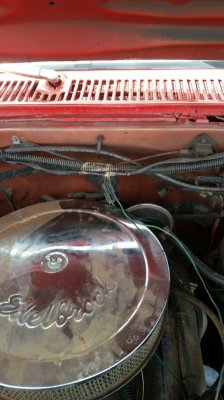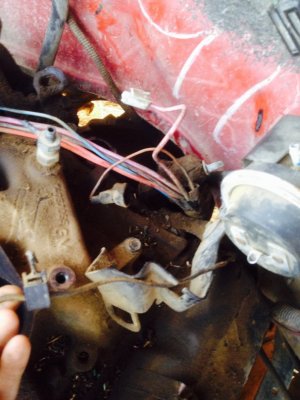I spoke too soon. It didn't fix it, but changed the way it acted. Now when it's running the gauge stays around 120. When the key is turned on but truck is not running, the gauge is around the 12 o'clock position.
The 12 o'clock (straight up & down ) position of the needle when de-energized is normal. Next check for full stroke.
Most people are not aware that these trucks have a test function for two dash indicators; the brake warning light and the coolant temperature indicator. This is mostly due to the fact that these checks occur only for a moment - and only when the engine is being cranked (key is in the START position). When in START, there is a set of contacts within the ignition switch that close and ground the negative side of the brake light and the sensing leg of the temperature gauge.
So, while the key is in START, the brake light is illuminated and the temperature gauge pegs high.
Doing this test (and getting the designed response) only confirms that the gauge is working correctly - it does not check any part of the sensing leg lead, the sensor or the interconnecting wiring.
If the temperature gauge goes full high while in START, it's okay. The next thing to check would be that the sensor is providing the correct variable resistance according to the temperature of the coolant. You will need a meter and have it set to ohms. Pull the sensing lead from the contact on the sensor. Using a test jumpers or the alligator clip attachments for your meter (if you have them), connect one meter probe to the sensor and the other to a good clean ground on the engine block. The jumpers/clips are only to allow you to do this hands-free. It takes awhile to do this and you don't want to be trying to hold the tips of two probes on tiny spots for 15 minutes and with the motor running.
Note: Unless you have an infrared gun to take temperatures or are ambitious enough to somehow get a test thermometer to read engine coolant temp - this test will only confirm that the sensor is providing a fairly close resistance. It wont tell you if it's perfect. You will only be able to check ohm values at room temp and operating temp. But honestly, that's enough. If I get good appropriate values at those two points - I call the sensor good.
Before starting the engine: With the engine completely cool - and knowing the ambient temperature - use the chart below and compare the resistance shown on the meter with the value shown on the chart for the air temperature. So, for example, if it's a 70 degree day and the motor is cold, the meter should read about 3400 ohms.
Start the engine and let it idle and warm up. As it begins to warm up watch the meter, the resistance should begin to drop steadily. It will drop quickly at first and then slow down as the coolant temp rises. Eventually the coolant will reach operating temp - which is dependent on the temperature rating of your thermostat. Don't use the exact number of the t-stat - I find that coolant generally runs about 10 degrees under t-stat rating. So a 195 degree stat will probably settle out at about 185. If you don't know the stat rating just use 190 degrees.
You know your truck better than anyone. So when you feel that it has had sufficient time to come up to where the dash gauge would normally stop climbing and settle out (if one were installed and functional) take another resistance reading. If you use 190 degrees as your operating temp, the meter should be reading somewhere around 250 ohms.
As noted above, this is just to check that the sensor is tracking along with the coolant temp fairly closely. If you get anything close to the values indicated on the chart - I would check the sensor off the list of possible problems.
The resistance value for the sensor - that makes your gauge read 120 when at operating temp - is about 1000 ohms. If the meter shows that value at oper temp, you can assume that the gauge is accurate, the wiring is good and that it is the sensor that is bad.
As far as whether you have the correct sensor:
There are only two basic types, a sender and a switch.
Senders are used to drive gauges. They may have different styles of spades for the connector, but since they are of the variable resistance design, they are not year/engine specific. As long as you have a GM sender it will provide a proper resistance according to temperature and the chart below (that chart is good for all GM cars trucks up till very recently).
Switches are used with warning lights and are of the normally open design. Resistance across a temperature switch will remain infinite up until a certain temperature. When that set point is reached the switch closes and resistance immediately and completely drops to zero. This grounds the warning lamp on the dash and it lights up.
You must be registered for see images attach



